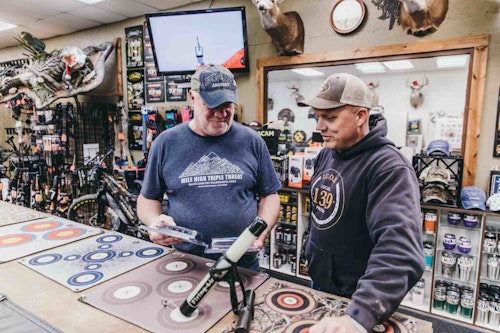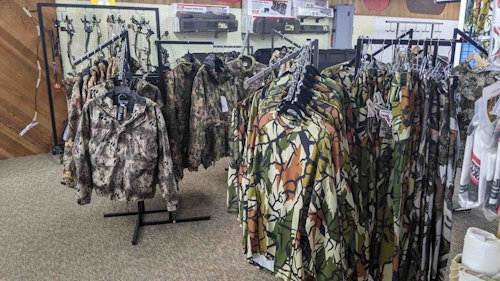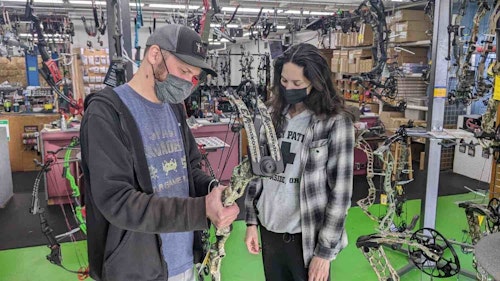
In every product category, always stock good, better and best options so you can offer something for every archer’s budget.
Once you learn what a customer is shopping for, the most fundamental sales questions to carefully pose is this: “Do you have a price range you’re looking to stay within?” Their response generally will provide some direction toward the next step, which is showing them a few different products within their stated budget.
Product pricing, of course, isn’t always indicative of quality. In other words, there are inexpensive products that overdeliver, but there are also expensive products that underdeliver. For that reason, your goal shouldn’t be merely to offer something in every price range, but to offer quality products in every price range.
Believe me, it’s easier said than done. Buying merchandise can be a complex and challenging undertaking, especially if you try to offer a few different great options within every budget. Yes, consider the cost and profit margin. That said, don’t purchase inventory you aren’t proud to sell. That applies to a $25 three-pack of broadheads as it does a $1,700 bow. If you can’t sell the item in question confidently and stand behind it, then don’t put it on your display peg. Period.
To that end, here are a handful of tips to help you navigate these often tricky waters.
A Good Buy On a Poor Product Is a Bad Buy
Generally, most archery manufacturers produce good-quality products, but like every industry, there are gimmicks and gadgets that promise big performance but grossly underdeliver. Watch out for these, because sometimes inexpensive costs with huge profit margins can lure you into buying poorly designed products — all you can see are those huge profit margins. Don’t take the bait.
Profit margins are very important to retail business; if you don’t make money, you don’t eat. But you have to consider the long-term consequences of selling cheaply made merchandise. Your customers will likely have problems with poor-quality items, and you know who they’ll come looking for when they do. Worse yet, they might not return and allow you to make it right. That means you lose their business forever. Purchase wisely. Let quality be your guide before profit margins.
Now, let’s discuss the three different pricing tiers and how to choose inventory in each.

Top, Middle, Bottom
When buying inventory for all three price ranges, there are a handful of considerations. Robert Kneeland of Archers Afield in Tigard, Oregon, provided some important criteria behind buying quality merchandise in every price range. He began by telling me about how Archers Afield approaches purchasing in the high-end price range.
“When buying high-end merchandise,” Kneeland began, “we ask ourselves if our customers will buy the product. Then, we must know what the profit margin will be, and if we’re going to make any money. Generally speaking, when you’re looking at high-end products, most are fairly equal in quality and craftsmanship, so it becomes a matter of which company we’re most comfortable working with at that point.
“In the high-end price range, it’s also very important to handle products backed by a solid warranty. We want to offer only high-end products that the manufacturer truly stands behind. Being able to take care of our customers is critical, and we can do that best when the manufacturer stands behind the product and our shop.”
Working down the ladder to the middle price range strips away some of the bells and whistles. Despite that, products in this range must deliver performance similar to high-end products. Basically, the middle price range is where value should meet performance. An example of this is a mid-range compound that shoots almost as accurately as a high-end bow, but has a slightly lower velocity and typically a cable guard instead of a ball-bearing roller guard.
“We look for robust features that deliver performance at a good value,” Kneeland explained. “This category isn’t all that hard to shop for because many of the high-end brands we handle also manufacture mid-priced products that are similar in design and performance with fewer features and a lower price tag. It pays to stick with brands that you trust, and it simplifies everything for you and your customers to focus on great brands.
“I have two examples of this. Black Gold offers both high- and medium-priced sights that per-form phenomenally, but they tend to be less expensive than similar competing brands. We feel the value is outstanding on a price-versus-performance comparison. Black Eagle Arrows is another great example. It delivers high-quality products at incredibly fair prices.”
At the bottom of the price ladder, it becomes very difficult to buy inventory that delivers performance and quality you can stand behind. Most of this merchandise lends itself toward beginners or those who have minimal budgets, but remember that what you sell these folks cannot be fall-apart cheap even if it is inexpensive. Like the middle and high-end price ranges, you must mine for the best.
“Think of it this way: You’re trying to find the best among the worst,” Kneeland said. “You have to look for the winners in this price category. The product must prove itself to work when you test it out and run it through its paces. Just because your low-end customers have little budgets doesn’t mean you can sell them junk. This price range is so important to offer because we don’t want to create any barriers to entry. We want our customers to be able to afford to get started in archery and bowhunting, but we also want to make sure we provide them with the best possible products in that price range.
“Often, we stick with one manufacturer per product category in the entry-level price range. This is a cluttered price range with tons of options, and we don’t want to complicate our customers’ shopping experiences by offering too many different choices. We stock a brand we believe in and that delivers a really decent product at a low price point. Obviously, that has been challenging over the last two years with the product-availability fiasco. Still, we find affordable products we know will perform.”
It requires some extra legwork to find and test a handful of different products, but your customer benefits from the hassle, so let’s talk about that next.

Try Before You Buy
When it comes to a new product concept or an uncharted product category, it usually isn’t wise to order sight unseen. Pictures are great, but they can deceive. I’m a firm believer that when a new product creates a big buzz, you really have to be careful. I’m not interested in the buzz it’s creating now. I’m interested in whether or not folks will still be talking about it six months to a year from now.
By all means, if you can pick up, hold and assess an archery product and determine if it will measure up to expectation before you buy it, that’s what you should do. Obviously, the ATA Show is a good place to touch, hold and sometimes test new products. You can also sometimes have a sales rep bring it in before you commit to an order. It’s so important not to jump on a sinking ship because everyone else is doing it. See for yourself if the product is a home run or a bunt.
“Results speak for themselves,” Kneeland said. “When we test items before buying, we run them through their paces. We put them on a few different bows. Several of us shoot with it. Nothing speaks louder than results. If we like how it performs and it doesn’t fail, it makes the cut. If the results fall short, we move on and look for something better. We want to be the ones to have a product fail, not our customers. They deserve the effort we put into identifying the best products for the money.”

Advertising Doesn’t Equal Quality
When meeting with sales reps, don’t get lured in by statements made about how many advertising dollars are behind the product launch. That’s fine and dandy, and it certainly will help dealers to sell more products, but it doesn’t mean the consumer will end up happy. A great product with minimal to no manufacturer advertising will be more difficult to sell in many instances, but it goes back to your conscience and the consumer’s satisfaction. Don’t sell some-thing because the manufacturer is spending money to advertise it. Sell what you believe in.
Final Thoughts
Of course, you can weed out a lot of products without testing just by studying the product’s construction. Steer away from plastic or other non-durable materials. Are there lots of moving parts? Does an arrow rest lack adjustability? Is a decoy clunky, heavy and noisy? Does the bow design look outdated? Try to identify all of the product’s negative points. If it has many, forget how much the profit margin is and walk away.
Let your conscience guide you. What you sell directly reflects your character and trustworthiness. If you wouldn’t trust the product for your own personal use, then don’t bring it in. In all three price ranges, strive to inventory only quality items in every price range. Do that, and you’ll have more satisfied long-term customers.
Sidebar: Guiding Newcomers
When I worked in archery retail, it was fairly common to have customers state that they hadn’t really considered a budget before coming in. These folks usually are newcomers who don’t know what it costs to get started. Don’t take advantage of them and suggest the highest priced items you stock.
Instead, take some time to explain the three different pricing tiers — good, better, best — and what each means in terms of quality and performance. In other words, help them to understand exactly what they’re getting by spending a given amount of money.
This is easy to do with compound bows. Start them in your test lane with a low-end bow, then let them test a mid-priced bow and finally a high-end bow. Most will be able to feel the difference. With other products like arrows, though, you’ll have to explain things such as spine straightness, weight tolerances and durability, because a newcomer often doesn’t know the difference between one arrow and the next.
After you’ve taken the time to show a customer that you genuinely seek to match them with the best gear for their money, they’ll generally let you guide them in the right direction. When you do, be sensitive to their finances and determine a total for what they’re buying, then ask if the price will work for them. If not, try to solve that problem by dropping to a lower price range while still matching them with quality products that will meet their needs.





